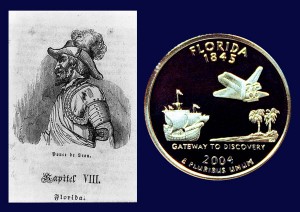Today, the Florida State Quarter Coin tells the story of the founding of Florida by Ponce de Leon 503 years ago.
The Guide to Florida published in 1876 provided the following account of the motivation and the discovery in 1512:
=====
Had Christopher Columbus, on leaving the Island of San Salvador, proceeded westward, he would have ultimately discovered the coast of Florida; for the Gulf Stream, then an unknown power, would have swept him to the northward — the difference of latitude required for the purpose.
But, influenced by the description of the natives, of a land of wealth bearing to the southward, he directed his prow thither, and brought up on the coast of Cuba. Thus was reserved to one of Columbus’ companions, (Juan Ponce de Leon,) the honor of the discovery of the peninsula, a most romantic incident of history.
In 1512, the brave old soldier, Ponce de Leon, was Governor of Porto Rico. He had carved his way to glory and wealth, but nevertheless aspired to equal Columbus in renown, and for that purpose fitted out an expedition.
It was whilst discussing the subject with his followers, and arguing as to the course to be pursued, that an Indian Cacique narrated to them a wonderful story; that, not many leagues away, towards the setting sun, there existed a land of great riches, and exceeding all others in beauty of scenery.
But, what was most extraordinary, it possessed a marvelous fountain, whose waters had the power to renew youth and give vigor to those who bathed in or drank them.
Ponce de Leon had witnessed such wonderful things in his several voyages, that he was prepared to give credence to the most exaggerated accounts.
“What if it should prove true?” soliloquized the old warrior, as he listened to the interpreter. “And why should it not be? Have I not already discovered marvels, which in my youthful days I would have deemed impossible as this? Ponce de Leon will, in giving to the world a rejuvenating fountain, be entitled to greater renown than those who merely gave wealth and continents to their sovereigns.”
An expedition of three vessels was immediately fitted out and set sail from St. Germain, Porto Rico, in March, 1512. Ponce de Leon directed its course to the Bahamas.
He visited the various localities where the fountain might be, but his search proved fruitless. Island after island was explored, and the waters tasted and bathed in, yet the desired effect was not produced.
Nothing daunted, the brave soldier steered to the westward; and, on Palm Sunday, the Pascua Florida of the Spaniards, (March 27th, 1512,) he discovered land ahead — a land of such magnificent vegetation and variety of flowers, that he gave to it the name it continues to bear — Florida.
On April 2, 1512, Ponce de Leon disembarked a little to the northward of St. Augustine, planted a cross, and took possession of the country in the name of his sovereign.
He then turned his attention to the search for the “Fountain of Youth; ” and, in its absence, gold and precious stones. He found neither, and two months later returned to Porto Rico.
In spite of his want of success, De Leon made a brilliant report of the value of his discovery, and was rewarded by the Crown with the title of Adelentado, or Governor of Florida ; in return for which he agreed to conquer and colonize it.
This, however, he did not appear in any particular hurry to do, as it was not until nearly ten years later that he again set out for the peninsula.
In the meantime, several explorers had visited its shores and described it as a vast continent, and not an island, as he supposed it to be.
At this time, Cortez was in Mexico; and the reports of his conquests and spoils incited Ponce de Leon to put on foot a second expedition, in the hope of meeting with a like success.
He sailed, therefore, with two vessels ; but no sooner had he landed in Florida, than he was attacked by the natives with such fierceness that, after a severe conflict, the Spaniards were compelled to re-embark and return to Cuba.
Ponce himself received a wound, from the effects of which he died, soon after reaching the island. His epitaph was : “In this sepulchre rest the bones of a man who was a Lion by name, and still more by nature.”
=====
The Florida State Quarter Coin shows beside a wood carved portrait of Ponce de Leon.
